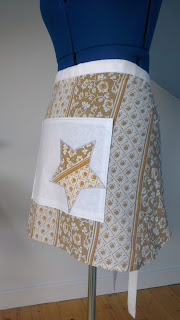What a rainy weekend it has turned out to be! I have spent much of my time at work so am hoping it will rain itself out as I head towards some much needed time off! Though I would take some time this morning to blog my tutorial on pleats.
I love pleats - they are cute and look gorgeous when done right. I love the shape they add to clothes and as you saw in my last post I've started to use them in bags as well. They can be adapted to any style you like and any shape or size so for me it is a must in your stash of sewing skills.
So what will you need - your fabric of choice, dress pins, a tape measure, tailors chalk, iron and a needle/sewing machine and thread.
1. You need to measure the length of your fabric and decide how big your pleats will be. I chose 2cm pleats to be every 4cms. This means that in total I will need 10cm per pleat because the fold uses 3x2cm of fabric. To work this out for your pleats take the size you chose for your pleat, times it by 3 and then add this figure to the gap you want between pleats. I marked this out along the top of the fabric using pen so you can see it but you will want to use tailors chalk that won't mark or run ink over your fabric.
So I have marked 0cm then 4cm then 8cm then 10cm. Then I repeat this again until I reach the end of the fabric.
2. You now want to start folding the fabric to create the pleats. You want to take the 8cm marking and bring it over the the 4cm marking
This should mean that the 10 cm marking sits just on the fold leaving you with a neat 2cm pleat. Pin this with the pin pointing up towards the edge of your fabric. Then you repeat the step taking the 8cm back to the 4cm and pinning until you reach the end of your fabric. You should be left with something a little like this.
As you can see it creates a nice curve to the fabric which is why pleating is often used for skirts - it perfectly sets up the waist band.
3. Now you want to press this out. This is a really important step if you want your pleats to sit nicely. The fabric should naturally show you how long the pleats fall - if you want a full pleat all the way to the bottom of your fabric you need to ensure you measure the pleats all the way down otherwise they will loose some of their shape.
4. Finally you run a straight stitch along the top of the fabric and remove your pins. While you are sewing check that the pleats aren't folding up under your machine foot (if your using a machine) and adjust as you got to ensure they are going through the machine perfectly flat.
Now you add this to your skirt or bag or whatever it is that you are using it for. This is a skirt that I made a year of so ago out of round table cloth. I used pleats to bring it in to fit me at the waist and it gives the skirt such a full feel - perfect for twirling I have to say :)
If you decide you want to do box pleats you follow the same idea except you turn the folds round. SO the first fold you would bring the 8cm to the 4cm mark. Then you would swap and bring the 4cm to the 8cm and continue alternating to create a boxed look on your product.
Have fun experimenting and as always give me a post of anything you produce!








